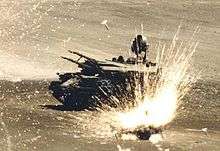BLU-97/B Combined Effects Bomb

The BLU-97/B Combined Effects Bomb is the submunition used in several cluster bomb type weapon systems. When the bomblets fall, they separate from the main bomb and independently free fall to the ground. They contain an inflatable bag (ballute) on the top of them, which slows them down and spreads them out. As the bomblets descend, they experience g-forces. Once they reach a minimum of 6 Gs they arm themselves. As the bomblets fall, they are also spinning as well. Arming takes about 2.6 seconds. They have a combined shaped charge, fragmentation and incendiary effect on the target. It is very effective against and mainly used for anti-personnel, anti-materiel, and anti-armor.
In 2003 humanitarian groups expressed concern that the BLU-97/B bomblets were the same size and color as food rations given to children in Afghanistan.[1][2] Although the latter are square and the former cylindrical, both are dropped from U.S. planes and both are yellow so that they are easy to spot on the ground. The United States responded to the outcry by changing the color of future food packages and warning civilians through announcements and flyers. Pentagon officials also said that the packages had not been dropped in the same areas as cluster bombs. [3]
Specifications
- Length:
- Stored: 16.8 cm (6.6 in)
- Deployed (w/o retarder canopy): 22.6 cm (8.9 in)
- Diameter: 63.5 mm (2.5 in)
- Weight: 1.54 kg (3.4 lb)
- Explosive:
- Standard: 287 g (0.63 lb) Cyclotol
- Insensitive Munitions (IM) version: PBXN-107
- Warhead: Shaped charge, fragmenting casing and incendiary zirconium ring.[4]
Weapon systems
References
- ↑ Geoff Keele (2 April 2003). "Concern that food ration and bomblet 'BLU 97' are identical in colour". UNICEF.
- ↑ "The use of cluster munitions in the war on terrorism.".
- ↑ "Fatally Flawed: Cluster Bombs and Their Use by the United States in Afghanistan". Human Rights Watch. 18 December 2002.
- ↑ BLU-97/B Combined Effects Bomb (CEB). GlobalSecurity.org